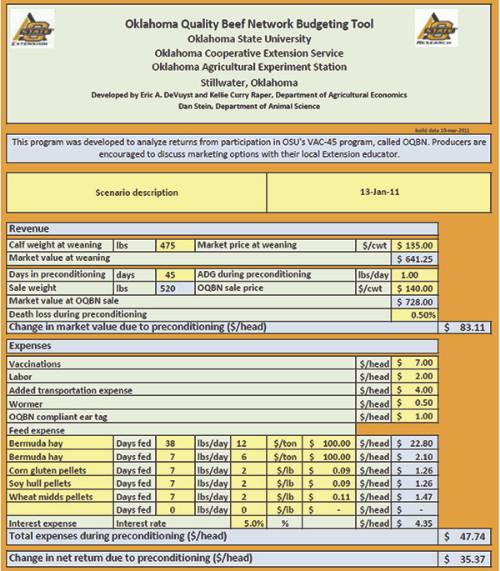Does Preconditioning Pay? A Benefit-Cost Decision Tool
Much attention has been given to the concept of preconditioning beef calves before moving them through the supply chain from the cow-calf producer to the stocker or feedlot phase. A preconditioning program for calves encompasses not only health and management practices such as long weaning (typically 45 days before marketing), breaking calves to eat from feed bunks, and a series of vaccinations (e.g. respiratory, blackleg), but also the common management practices of castration and dehorning. The Oklahoma Quality Beef Network is one example of a certified preconditioning program with marketing opportunities offered through special value-added calf sales. The OQBN example preconditioning protocol can be accessed at http://www.oqbn.okstate.edu. While it is unknown exactly how many Oklahoma calves are marketed as preconditioned calves (certified or uncertified), estimates suggest that less than 5 percent of calves in Oklahoma were enrolled in any type of value added marketing program in 2007, including preconditioning programs (McKinney, 2008).
Research has shown that home-raised calves managed with a preconditioning protocol before marketing will generally perform better as stockers and/or feeders (Lalman and Smith, 2002). In a survey of feedlot owners, Avent, Ward and Lalman (2003) reported that managers saw significant advantages in performance from preconditioned calves, ranging from reduced health costs to improved feed conversion. For many, that improved performance translates to a willingness to pay a premium for preconditioned calves over non-preconditioned calves.
But what’s in it for you? From a producer perspective, preconditioning not only results in physical benefits for the calf and performance benefits for the stocker or feedlot owner, but it also results in the producer selling additional weight. Typically, spring born calves are weaned in early to mid-October and delivered to market. Calves entering a preconditioning program are usually kept on the ranch an additional 45 days through late November or early December. Those additional pounds gained during the preconditioning period are often sold as market prices begin a seasonal upswing. Donnell, Ward and Sweigert (2007) found a seasonal price upswing between mid-October and early December in 12 of 15 years in the Oklahoma City market.
Of course, preconditioning is not free. Many producers who do not precondition calves before marketing are not convinced that the value gained outweighs the cost incurred. This fact sheet presents a spreadsheet budgeting tool for estimating the returns of preconditioning calves for an individual producer.
Benefit-Cost Worksheet
The program is developed in MS Excel 2007. Most features, other than formatting, are compatible with previous versions of MS Excel. The worksheet, seen in Figure 1, has two components: Revenue and Expenses. The user provides information in yellow cells. Cells with a blue background are automatically calculated by the program.
Figure 1. Oklahoma Quality Beef Network Budgeting Tool Input Screen.
Revenue
The Revenue portion allows the user to input expected prices, expected gains, and days held beyond weaning. The information provided by the user is then used to estimate revenue with no preconditioning and revenue if calves are marketed as preconditioned calves. Primary components of additional revenue garnered from preconditioning are price premiums and additional pounds sold. Estimated death loss is included in the revenue section as a reduction in revenue received and assumes that all expenses are incurred before death. Please note, however, that death loss in home-raised preconditioned calves is typically quite small.
Expenses
The Expenses section requires that user enter relevant costs, including interest costs, for retaining calves beyond weaning in a preconditioning protocol. The spreadsheet tool is designed so producers can individualize expenses to fit their particular operation. For example, producers may use various combinations of forage and processed feeds for different time periods. Producers have the option of entering feed price on a per pound or per ton basis. Preconditioning calves also requires additional labor. Preconditioning programs typically require a program ear tag. In the case of OQBN, the tag cost is $1/head. Additionally, for some producers, extracting the maximum benefit from a preconditioning program may mean they will market those calves in a different location than they typically market their calves. The tool allows producers to capture any additional transportation costs attributable to a change of marketing locations.
Net Returns
Net Returns from preconditioning are reported on a per head basis and are calculated by subtracting preconditioning expenses from additional revenues gained.
Summary
Previous studies have documented the profitability of preconditioning calves. Given the low adoption rate of preconditioning in Oklahoma, the OQBN program was established to provide Oklahoma cow-calf producers with brand-neutral access to a preconditioning program, education and supporting research. The worksheet described here provides a tool for producers to analyze the expected returns from preconditioning. The worksheet can be downloaded for free at: www.agecon.okstate.edu/faculty/publications/3943.xlsx.
If you have questions regarding the program, contact Eric A. DeVuyst, (405) 744-6166, eric.devuyst@okstate.edu.
References
Avent, R. Keith, Clement E. Ward, and David L. Lalman. “Economic Value of Preconditioning Feeder Calves.” Oklahoma State University, Oklahoma Cooperative Extension Service Fact Sheet AGEC-583. 2007.
Donnell, Jeri, Clement E. Ward, and Steve Sweigert. “Costs and Benefits Associated with Preconditioning Calves.” Oklahoma State University, Oklahoma Cooperative Extension Service Fact Sheet AGEC-247. 2007.
Lalman, David, and Robert Smith. “Effects of Preconditioning on Health, Performance and Prices of Weaned Calves.” Oklahoma State University, Oklahoma Cooperative Extension Service Fact Sheet AFS-3529. 2002.
McKinney, Doug. “Marketing Opportunities Available to Oklahoma Beef Producers.” Oklahoma State University, Oklahoma Cooperative Extension Service Fact Sheet ANSC-3288. July 2009.
Kellie Curry Raper
Livestock Marketing
Eric A. DeVuyst
Farm Management and Production Management
Daniel Stein
Assistant Professor, Animal Science

